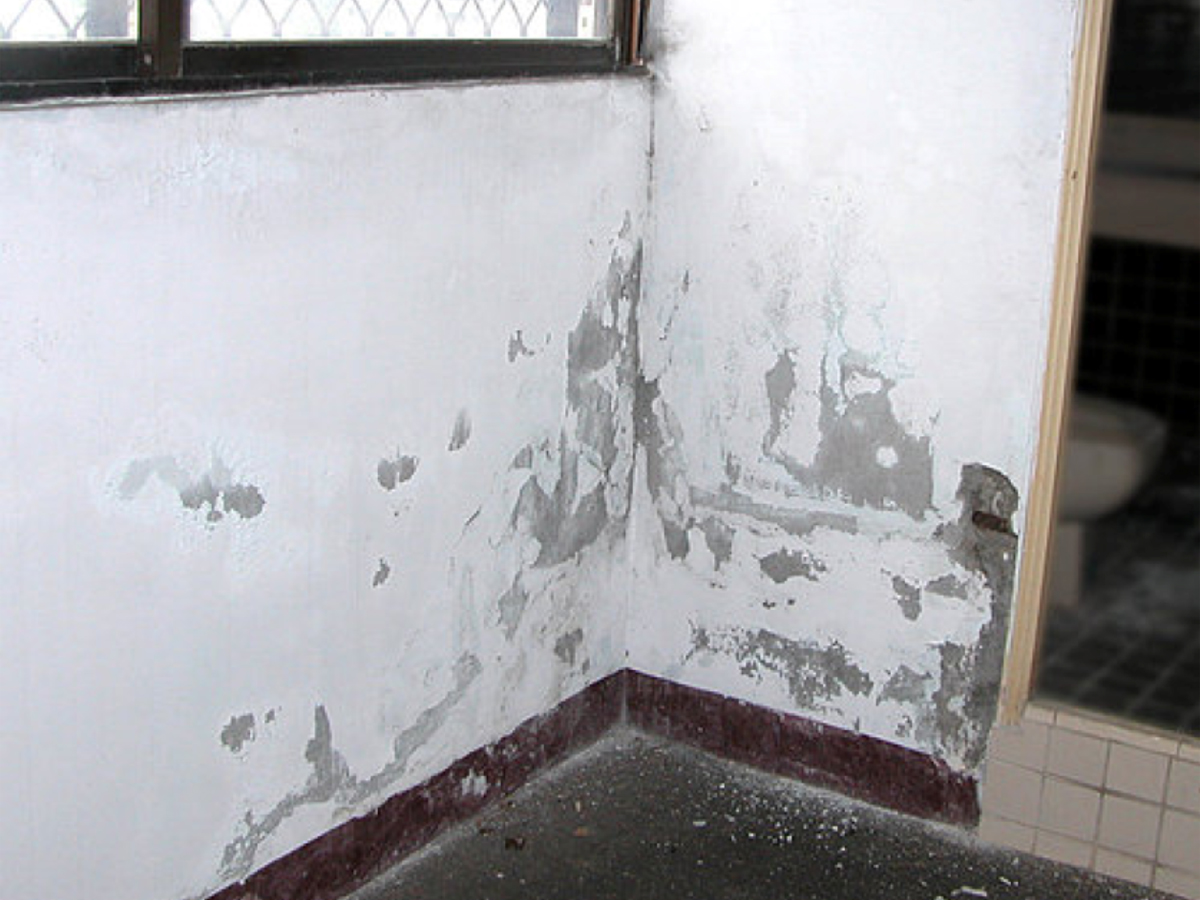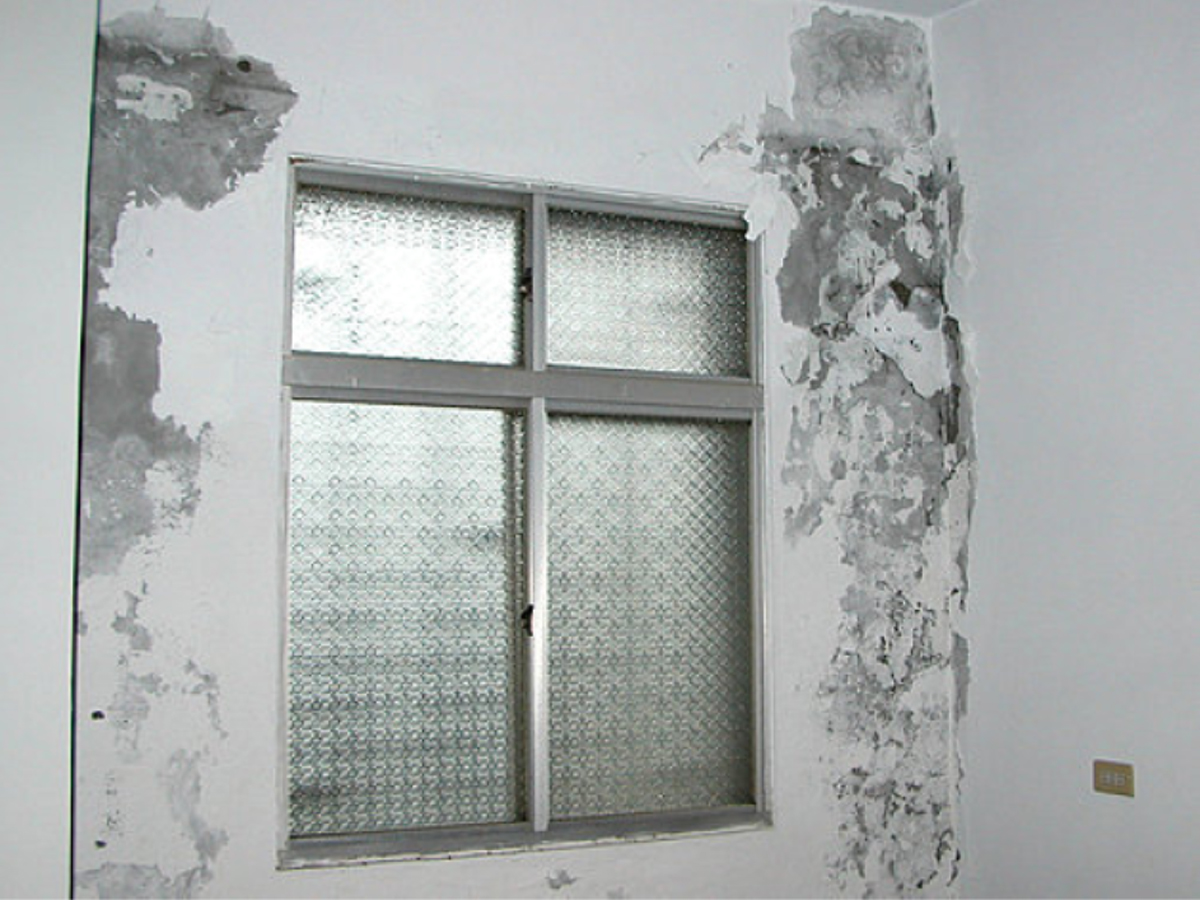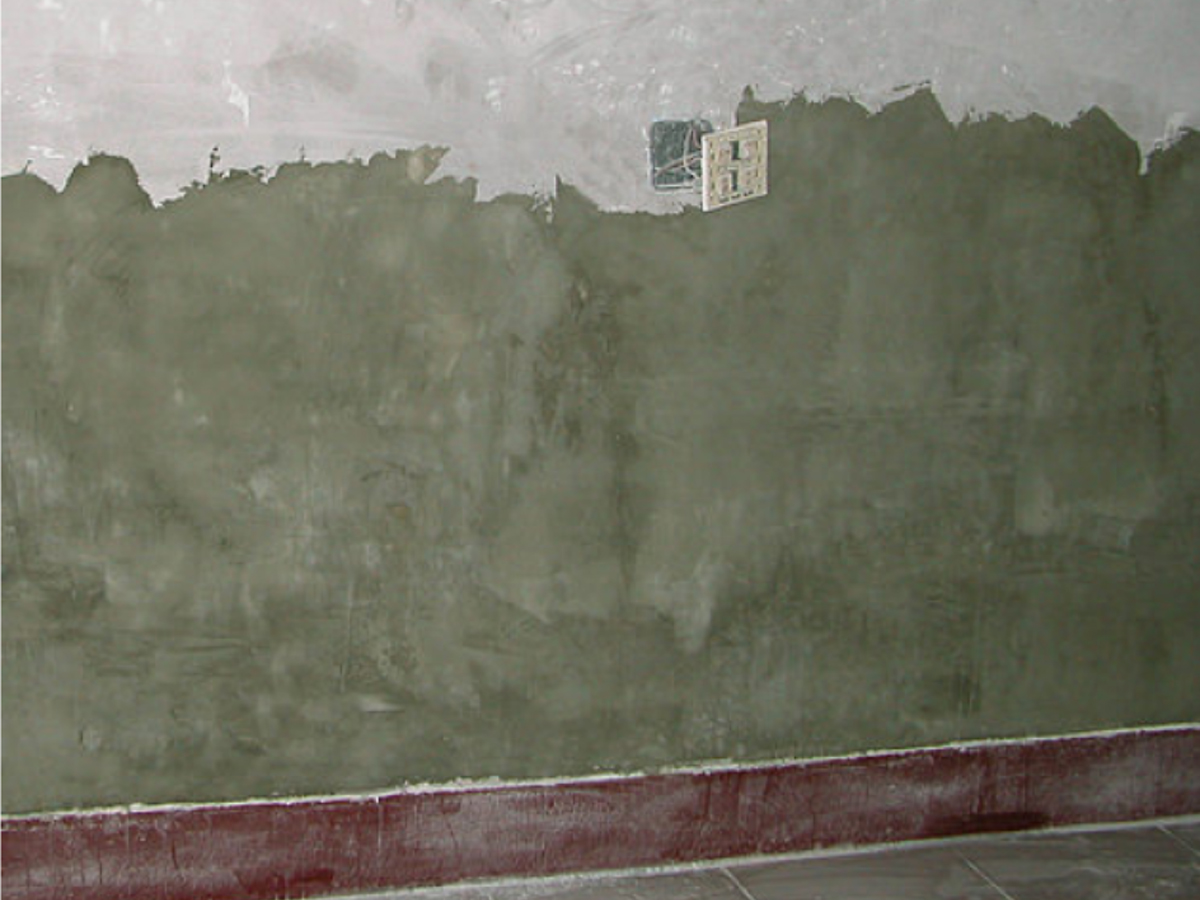

Wall efflorescence cause by basement leaking problem

Wall efflorescence cause by window-edge leaking problem

Wall efflorescence treatment: grind off the old paint layer and trowel the S11-Superior Waterproofing Cement Resin
1. What is wall efflorescence?
"Wall efflorescence" is a common household issue; almost every house has such problem. Lacking for correct knowledge of "wall efflorescence", most chemical engineers and waterproofing constructors gave it a wrong name called "wall cancer" simply by seeing the problem of leaking, oxidation and peeling on the wall. Later on there were chemical engineers who collected sample from the "wall cancer" and analyzed it. They discovered there were no cancer cells in the "wall cancer" actually, but it simply contained highly sodium, potassium and the mold. Since then, the market has been occupied with countless treatments for wall efflorescence, and most of the treatment contains chemicals such as diluted-acid, resin, bactericide and so on. However, most consumers did not find any effect with those products, and the difficulty of cure just veiled wall efflorescence with mystery.
"Wall efflorescence" is a phenomenon that water or humidity penetrates the leaks or holes on the wall or even to the construction of the building, causing oxidization and efflorescence interaction which lead to severe peeling problem to the wall. Most constructors do not carry out waterproofing work or choose cheap and ineffective elastic cement, especially on the place where are highly-contacted with water such as the exterior wall, bathroom, basement, balcony and the garden. Therefore, within 3 to 5 years, wall efflorescence comes along and leads to serious paint or plaster peeling problem on the wall.
2. "Wall efflorescence" can be prevented and cured.
Since the essential problem of wall efflorescence is caused by humidity penetration, what we have to do is simply checking on the efflorescent part, finding out the source of water or humidity and cut it off. For example, there is serious efflorescence on the top floor ceiling, from which we know it is caused by the rain that constantly penetrates and oxidizes the plaster as well as the RC structure, so the capillary action occurs and the paint starts to peel. You only need to choose climate-tolerant, waterproof, plaster-compatible, and strongly adhesive waterproof materials, then the efflorescence problem on the top floor ceiling could be solved easily.
3. How to deal with common "wall efflorescence"?
- How to deal with paint peeling problem on the exterior wall and downstairs ceiling of the bathroom? When you find the efflorescence problem is serious on the exterior wall and downstairs ceiling of the bathroom, the first thing you need to do might be tearing off the original bathtub, floor tiles and wall tiles (1.8M). Next apply the waterproof, strongly adhesive and plaster-compatible S11 Superior Waterproofing Cement Resin before tiling. Do not forget to check out if there is any leaking problem on the pipeline of the bathroom at the same time. If yes, please repair the pipeline before the waterproofing construction.
- How to deal with interior wall efflorescence? Interior wall efflorescence is normally found on the windward side of a building. In addition to applying two layers of S1 Superior Waterproofing Cement Resin plus three layers of F1-C Elastomeric Waterproofing Cool Resin on the windward exterior wall, if oxidation and efflorescence is serious, the affected area must be completely grinded out before troweling two layers of S11 Superior Waterproofing Cement Resin and finishing with paint, or the paint could not stick to the will and would come off over again.
- How to deal with the wall efflorescence on structural leaks? Just cut, reinforce and seal up the leaks and the work is done.
- How to deal with the wall efflorescence caused by the leaks of the pipeline? From the leaking location, water amount, and the leaking time, we could tell which kind of pipeline is leaking. Once the pipeline is repaired then the problem is solved.
4. Wrong treatment for wall efflorescence.
- Demolish the old plaster to cover a new layer on the wall, or paste the new tiles directly on top.
- Use the "wall efflorescence" prevention spray.
- Cover up the wall with wood boards, which fasten the process of oxidation instead.
- Cover up the exterior wall with steel sheets.
- Use cheap waterproof materials such as paint, elastic paint, and elastic cement.
Taiwan is located in the subtropical zone which features the humid and rainy environment. Along with the rapid industrial and commercial development over these years, the soil is wildly polluted and the construction material is severely deteriorated. For those reasons, in spite of having saved hard and bought a new house, most people could not escape from the disaster of getting a defective one with serious leaking problem in the end. Therefore, it is important that we take more attention to waterproofing construction.
Most people think the waterproofing construction is needed only when the leaking problem comes up in their house. What they don't realize is that, just like a car, a house also needs regular check and maintenance, and the maintenance circle depends on the quality of the waterproof materials which had been used. Asphalt felt and pitch were commonly used in tradition, however the maintenance should be taken every half a year. If using paint or so-called waterproof paint, the maintenance should be taken once in two years. If using the elastomeric cement or so called PU resin, it would have to be removed before applying new layers as maintenance within two years. Normally we can find several construction materials on the market, such as paint, elastic paint, ceramic tile, granite, and stone paint; however most of which are decorative or water-resistant, not hundred-percent waterproof. Some people would find the plasterer to solve the leaking and efflorescence problems of their house. The plasterer would only remove the old plaster and apply a new one, paint the wall and tile it up. Others with serious leaking problem would even call a SRC worker to demolish all rooftop plaster, lay the reinforcing bars and fill in a 15cm-thick grout. All these wrong resolutions do not only waste a lot of money, but they also do severe harm to a house.
When the plasterer or SRC worker is knocking away the original plaster, the huge vibration caused from the electric concrete breaker would lead to the structural damage to an old house. Also, with 300 kilograms of concrete and plaster covered afterward per square meter on the rooftop, there is no doubt when an earthquake comes to a 1000 square meters house pressed by extra 30 tons of concrete, the vibration and swinging force would cause an instant pulling and shearing force that could easily destroy the structure of a house. The wall and structural pillars might break immediately and put the house in danger of collapsing!
Please remember, instead of thickness, density is the only thing needed when it comes to waterproofing construction. Before finishing building a new house, the constructor should apply waterproof materials to the exterior wall, window edge, bathroom, balcony and the roof floor, and trim them up with wall decorative materials or paint. In this way, not only does it minimizes the humidity in the house and prolongs the life time of the building, but it also helps slow down aging speed and prevent cracks on the structure.
Once you have the right concept about home waterproofing, it's time for discussing the way to choice a good waterproofing material.
- 10 years or above life time (good weather resistance).
- High water resistance, does not hydrolyze in water for years.
- Strong adhesion and high density.
- Nontoxic nor pollutant.
- Easy to apply (can DIY).
- No need of removal before maintaining and mending work.
- Grouting, tiling and painting work could be processed directly after the construction. (Function as interface.)
- Easy to remove on expiration of its life time.
- Good elasticity and precaution against earthquakes.
- Contain both waterproof and heatproof function.
- Could be wildly applied on various building materials. (RC, stainless steel, wood, stone…etc.)
- Dry quick after construction. Save much time for follow-up works.
- No need of primer nor topcoat. Construction could be done with only a few kinds of materials.
Inappropriate waterproofing engineering methods:
- Replace waterproofing materials by ceramic tiles or stone. (Defect: costly, low density.)
- Replace waterproofing materials by painting or paving with grout. (Defect: costly, low density.)
- Replace waterproofing materials by both laying reinforcing bars and filling in grout. (Defect: influence on structural safety, low density.)
- Choose inferior waterproof materials with short life time (6 months to 1 year) or need frequent maintenance, such as pitch, asphalt, asphalt felt, and PU resin.
- Replace waterproofing construction by using iron sheets to build the rooftop. (Defect: costly, ineffective, risky.)
- Using corrugated iron sheet to cover the exterior wall, which block humidity in the joints and deteriorate the efflorescence problem.
- Using PU resin waterproof material which has several defects such as water-intolerance, high thermal expansion coefficient, low density, short life time, difficult to be constructed and removed.
- Using AB elastomeric glue which has several defects such as water-intolerance, low density, low adhesion, and short life time.
Once the waterproof work of the bathroom was not carried out properly during the process of house construction, "wall efflorescence" will show up on the exterior wall and downstairs ceiling right under the bathroom easily in the near future. What's worse, the room decoration on which you have spent large amount of money might be ruined by severe leaking problems. To solve the problem, all tiles and the bathtub must be knocked off before applying waterproof construction and end up with retiling, which would be a really huge job to do. Therefore, when you are buying a house or repairing the bathroom tiles, it's very important to ask the constructor to do the waterproofing job well in advance. Now we are going to talk about the correct performance of bathroom waterproof construction.
- Check the cold and hot pipelines and see if there is a leaking problem. Fix the hot one first if both pipelines are broken. It is suggested to replace the pipeline with stainless steel one if it is made of iron.
- Check on the floor tiles of the bathroom. Any crack must be reinforced and sealed up thoroughly in advance.
- Add the curtain or sliding door to separate washroom and bathroom, or choose a walk-in bathtub instead.
- The toilet must be fixed tight when installed. Using the S11 Superior Waterproofing Cement Resin to advise strong adhesion. The sewer pipe must be aligned to the toilet's.
- To prevent the tiles form bulging and cracking in the future, use the S11 Superior Waterproofing Cement Resin for waterproofing material which is water-resistant, anticorrosive from long-term of soaking in the water, strong adhesive, and plaster-compatible.
- Addition to waterproof construction on the floor, the application should be done over the wall for 180 cm high.
- Inappropriate waterproof materials:
- PU resin (Defect: water-intolerant and poorly adhesive.)
- AB elastomeric glue (Defect: water-intolerant, low-density and poorly adhesive.)
- Epoxy resin (Defect: ineffective as interface so would lead to bulging and cracking problems easily.)
- Elastic waterproof paint (Defect: water-intolerant and ineffective as interface.)
- Waterproof blanket (Defect: lead to bulging problems and the joints are split easily)
- Mix the grout into waterproof paint (Defect: low-density)
As there has been great improvement made on waterproof coating for the past few years, the waterproof function, climate tolerance and even the heatproof function of water-based waterproof coating has been highly advanced as well. Therefore, without covering any protective layer on top, the life time of waterproof coating has prolonged from 2-3 to 15-20 years.
Without covering additional protective layer, traditional waterproof materials such as the asphalt felt, PU resin and the waterproof blanket which are extremely inefficient on climate-tolerance would not sustain for more than 3 years. To prolong the life time, most construction companies would cover the plaster or cement for protection, not realizing such engineering method is doomed to failure. One reason is these materials all have high water absorption rate, so the water-intolerant PU resin, elastic cement, and waterproof blanket are easily hydrolyzed. The other reason is these materials are not anti-seismic. Once there come the earthquakes or the thermal expansion/contraction that acts on the building, the tension and the shearing force would cause cracks on the structure and tear the waterproof layer on the original crack easily and the whole waterproof engineering would be totally in vain. To solve the problem thoroughly, it needs a comprehensive excavation and finding out the leaks so that the cutting, reinforcement, anti-tension, and anti-sheering waterproof engineering could be carried out, which is really a huge working process. Since most public offices of construction in Taiwan are still adopting the traditional covering-type waterpoof engineering method, tragedies are putting on stage over and over again.
Today, Tropicalfish Coating Co. is proud to introduce our water-based waterproof coating which has taken 21 years of development, the one with 15-20 years of life time without any coverage on top, would sustain long-term soaking in water, and contains extraordinary both heatproof and anti-seismic function. Under such great progress on waterproofing coating being made, the "open-type waterproof engineering method" would replace the traditional one completely with its superior qualities of quick maintenance, easy to carry out, and low cost.
| S1 Superior Waterproofing Cement Resin | Elastic Cement | PU Resin | EPOXY Resin | |
| Function as Interface | Very Good | Passable | Bad | Bad |
| Humidity for Construction Surface | >50% | >50% | Must be total dryness | Must be total dryness |
| Thickness per Layer | 0.3(m/m) | 10(m/m) | 3(m/m) | 3(m/m) |
| Waterproof Method | Penetrate the Pores | Waterproof Coating | Waterproof Coating | Waterproof Coating |
| Time Needed for Total Dryness | 4~8 hours | 1 Day | 2~3 Days | 2~3 Days |
| Tiling Condition | Tile Directly | Tile Directly | Spread 7 mm stone before tiling | Spread 7 mm stone before tiling |
| Water Tolerance | Can be soaked in water for a long period of time | 3 Days | 5 Days | Can be soaked in water for a long period of time |
| Toxicant | No | No | Evaporate toxic gas | Evaporate toxic gas |
| Against UV Rays | Very Good | Bad | Bad | Bad |
| Application Efficiency(M2 per Application) | 80~100 | 25 | 30~40 | 20~25 |
| Application Method on the Wall | Troweling/ Spraying/ Painting | Troweling/ Painting | Spraying Only | Spraying Only |
| Against Wall Efflorescence | Good | Bad | Bad | Passable |
| Waterproof Density | Very Good | Bad | Passable | Passable |
| Life Time | 15~20 years | 2-3 years | 2-3 years | 1-2 years |
| Counter Hydraulic Pressure | Good | Bad | Bad | Bad |
| Primer | Does not need | Need | Need | Need |
| R.C. Plaster Compatibility | Very Good | Passable | Bad | Bad |
| S1 Superior Waterproofing Cement Resin | S11 Superior Waterproofing Cement Resin | Elastic Cement | |
| Water Tolerance | Can be soaked in water for a long period of time | Can be soaked in water for a long period of time | 3 Days |
| Pool/Water Tank Waterproofing | Good | Extremely Good | Bad |
| Cover Extra Protection | Do not need | Do not need | Need |
| R.C. Plaster Compatibility | Very Good | Extremely Good | Passable |
| Thickness per Layer | 0.3m/m | 0.5m/m | 1m/m |
| Time Needed for Total Dryness | 4~8 hours | 4~8 hours | 1 Day |
| Tiling Condition | Tile Directly | Tile Directly | Tile Directly |
| Waterproof Density | Very Good | Very Good | Bad |
| Counter Hydraulic Pressure | Good | Extremely Good | Bad |
| Against Wall Efflorescence | Good | Extremely Good | Bad |
| Toxicant | No | No | No |
| Against UV Rays | Very Good | Very Good | Bad |
| Primer | Does not need | Does not need | Need |
| Application Method on the Wall | Spraying/ Painting | Troweling/ Painting | Painting |
| Dripping after Troweling on the Wall | No | No | Yes |
| Life Time | 20 years | 20 years | 1-2 years |
| Tropicalfish Coating F1-C Elastomeric Waterproofing Cool Resin | Dulux Waterproof Paint | Yu Lung Enterprise PU Waterproof Glue | Dulux Anti-Crack Emulsion | KARNAK#100 Emulsified Asphalt | |
| Primer | Does not need | Need | Need | Need | Need |
| Top Coat | Does not need | Need | Need | Need | Need |
| Water Tolerance | Good | Bad | Bad | Bad | Bad |
| Toxicant | No | Nil | Yes | Yes | Yes |
| Property | Water-base | Water-base | Oil-base | Water-base / Oil-base | Emulsified oil-base |
| Package | 15 L | 18 L | 18 L | 18 L | 18 L |
| Usage on Plane Surface for 3 Layers (per Bucket) | 33 M2 | 13 M2 | 13 M2 | 13 M2 | 10 M2 |
| Heat-proof Function | Good | Nil | Nil | Nil | Nil |
| Life Time | 15~20 year | 2~3 year | 2~3 year | 2~3 year | 2~3 year |
| Cover Extra Protection | Do not need | Need | Need | Need | Need |
| Tropicalfish Coating Cl Cooling | Tropicalfish Coating F1-C Elastomeric Waterproofing Cool Resin | Dulux Waterproof Roof | Kingcat Paint Water-Based Heat Resistant Waterproof Paint K1-202 | Kingcat Paint Anti-Heat Water-Proof Paint K1-222 | Nippon Paint Cooling-Paint | |
| Heat-proof Principle | (cns12381)Solar radiation reflectance 84.2% (CNS12381) | Solar direct reflectance 83.7%(ISO9050) | Nil | Hollow ceramic nanoparticles for heat resistance | Hollow ceramic nanoparticles for heat resistance | Hollow ceramic nanoparticles for heat resistance |
| Temperature Difference on Iron Sheet Surface | 20~30℃(No temperature rise on the surface) | 20~30℃(No temperature rise on the surface) | No data(Temperature rise on the surface) | 15~20℃(Temperature rise on the surface) | 15~20℃(Temperature rise on the surface) | 15~20℃(Temperature rise on the surface) |
| Temperature Difference in the Building | 6-8℃ | 6-8℃ | No data | 3~4℃ | 3~4℃ | 3~4℃ |
| Primer | Does not need | Does not need | Need | Need | Need | Need |
| Top Coat | Does not need | Does not need | Need | Need | Need | Need |
| M2 per Layer | 266 M2 | 150 M2 | 33 M2 | 53~60 M2 | 33~40 M2 | 50 M2 |
| Water Tolerance | Good | Good | Bad | Bad | Bad | Bad |
| Toxicant | No | No | Nil | Nil | Yes | Nil |
| Life Tine | 6 years | 15-20 years | 2-3 years | 1~2 years | 1~2 years | 1~2 years |

